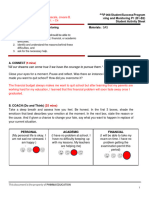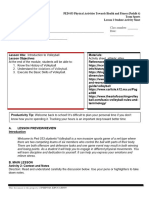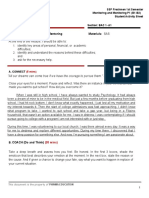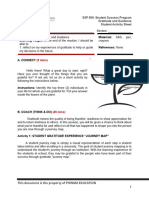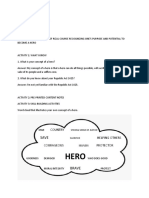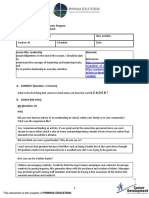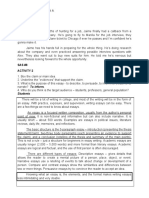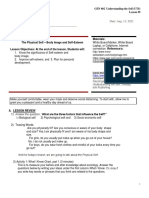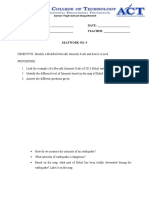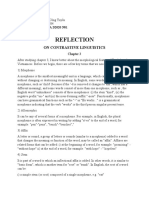Decision Making SAS
Decision Making SAS
Uploaded by
Princess EscandalloCopyright:
Available Formats
Decision Making SAS
Decision Making SAS
Uploaded by
Princess EscandalloCopyright
Available Formats
Share this document
Did you find this document useful?
Is this content inappropriate?
Copyright:
Available Formats
Decision Making SAS
Decision Making SAS
Uploaded by
Princess EscandalloCopyright:
Available Formats
Course Code: SSP (Year 1-Sem.
2)
Module #12 Student’s Activity Sheet
Name: Princess Roly Ann C. Escandallo Date: March 22, 2023
Section: 1BSMLS-A9
Lesson Title: Decision-Making Materials: SAS
Learning Targets: References:
At the end of the module, I will be able to:
1. explain the 5 steps in decision making; and https://www.mirasol.net/blog/five-step-deci
2. apply the process of effective decision-making in other sion-making.php
aspects of my life.
https://harappa.education/harappa-diaries
/herbert-simons-decision-making-
theory/
A. CONNECT (5 mins)
Hello there! Welcome to our decision-making part 2!
This module is designed to complement the previous semester’s session, helping you stay and excel in
college. Since there are numerous non-academic concerns a freshman college student may face, this module
was created to help you deal with these concerns.
We hope that the procedures discussed in this module will help you in situations that might prevent you from
reaching your goals.
B. COACH
DO and THINK (55 mins)
This document is the property of PHINMA EDUCATION 1
Course Code: SSP (Year 1-Sem. 2)
Module #12 Student’s Activity Sheet
Now, it is time to reflect and apply this to yourself!
Think of a current problem or concern you have related to the course you chose or the course that was chosen for
you. Use the “Five Steps in Making A Decision.”
1. State what the problem is
I had difficulty managing my time.
1. Think of ways to solve (alternatives) the problem
1. Set a To-Do list.
2. Break down large tasks
3. Use tools to schedule your tasks
4. Use breaks to your advantage
5. Ask for help
2. Review each way/alternative to solve the problem and list all the things that could possibly
happen.
Alternative Ways Possible Consequences
1. Set a To-Do list. 1. I’ll be able to organize my tasks and prioritize my
time efficiently.
2. Break down large tasks 2. Breaking down large tasks into smaller, allows for
a clearer understanding of the task at hand and
can help identify potential roadblocks or areas
where additional resources may be needed.
3. Use tools to schedule your tasks 3. Scheduling tasks can help increase productivity
and ensure that important deadlines are met.
With the help of various scheduling tools, I can
easily manage my workload and stay on track.
4. Use breaks to your advantage 4. Taking regular breaks allows me for better focus
and concentration when returning to study.
However, it may cause distractions and I won’t be
able to get on track
This document is the property of PHINMA EDUCATION 2
Course Code: SSP (Year 1-Sem. 2)
Module #12 Student’s Activity Sheet
3. Decide on the alternative that seems best and write it out.
I think breaking down larger tasks is the most efficient way to manage my time. By breaking
down larger tasks into smaller ones, I will be able to focus on one task at a time and feel a sense of
accomplishment as I complete each one. Furthermore, this allows for a clearer understanding of the
task at hand and can help identify potential roadblocks or areas where additional resources may be
needed. This approach can also help me prioritize my tasks and manage my time more effectively.
4. Evaluate the decision. Use the final decision for making a plan for carrying out the decision; use the
plan to set goals.
The "breaking down tasks" approach helps in identifying the most important tasks and allocating time
accordingly. Additionally, it also helps in avoiding procrastination and staying on track.
STEPS:
1. Figure out how much time I have. Count backward from the project’s due date to see how many
days I have left to complete it.
2. Figure out how long each session should be. Estimate how much stamina I will have for the kinds
of work involved.
3. Write down each task. Write down on index cards every task the assignment involves, from going to
the library to designing the report cover.
4. Put the task cards in order. Decide what comes first, second, etc. For instance, doing research
comes before proofreading the paper.
5. Assign a deadline for each task.
6. Review my progress.
This document is the property of PHINMA EDUCATION 3
Course Code: SSP (Year 1-Sem. 2)
Module #12 Student’s Activity Sheet
C. CHECK (30 mins)
Personal Reflection
1. How did you feel with today’s activity? Draw an emoji that best explains your feeling and write a short
explanation about it.
I am happy today, and there's no deep reason for that. I believe that having a positive outlook on life
can greatly improve one's mental and emotional well-being, leading to a happier and more fulfilling life. That's
why I'm more focused on the good things in life, no matter how small they may seem, as they can bring joy
and positivity into my daily experiences.
2. What did you find out about yourself today that makes you proud?
I learned a lot and grew from my mistakes. As I reflect on my past experiences, I now understand that
making mistakes is a natural part of the learning process and has somewhat helped me become a better
version of myself. I am grateful for the lessons I've learned, and I look forward to continuing to grow through
future challenges.
3. What is your greatest take away from today’s lesson when it comes to decision making?
Big decisions never limit your options. I've realized that everytime I make big decisions, I open up new
opportunities and possibilities that I may have never considered before. I just need to be confident, never
doubt myself, embrace change and take risks for this will lead to my growth and success in all aspects of my
life. I may fail, but that also means that I can be better the second time around.
This document is the property of PHINMA EDUCATION 4
You might also like
- Gen 002 Sas 15Document3 pagesGen 002 Sas 15JeameNo ratings yet
- Culminating Activity 2021 - Btt1O-A Franchise Proposal (20%)Document2 pagesCulminating Activity 2021 - Btt1O-A Franchise Proposal (20%)GR - 09CT 733899 North Park SSNo ratings yet
- 6) Decision Making SASDocument4 pages6) Decision Making SASPrincess EscandalloNo ratings yet
- Laurito - SSP Ace - SasDocument2 pagesLaurito - SSP Ace - SasKristine Mae LauritoNo ratings yet
- PANSACALA, JOVANE (SSP #2 & 3 Monitoring and Mentoring P1 (B1-B2) )Document3 pagesPANSACALA, JOVANE (SSP #2 & 3 Monitoring and Mentoring P1 (B1-B2) )Jovane Bacalso PansacalaNo ratings yet
- SSP 006 - Monitoring and Mentoring (B1-B2) - (SAS)Document4 pagesSSP 006 - Monitoring and Mentoring (B1-B2) - (SAS)Kiara MontillaNo ratings yet
- Subject: SSP 005: Student Success Program Module #8 Student Activity SheetDocument4 pagesSubject: SSP 005: Student Success Program Module #8 Student Activity SheetEureka SatorreNo ratings yet
- PED 033 Lesson 2 SASDocument7 pagesPED 033 Lesson 2 SAStrfe.arguelles.auNo ratings yet
- Growth Mindset + Study Skills SAS 2nd SemDocument6 pagesGrowth Mindset + Study Skills SAS 2nd SemAlyssaNo ratings yet
- SSP 005: Student Success Program Module #7 Students Activity SheetsDocument8 pagesSSP 005: Student Success Program Module #7 Students Activity SheetsEureka SatorreNo ratings yet
- Sas#1-Gen 005Document7 pagesSas#1-Gen 005Aldrin CamatNo ratings yet
- What Should Be The Ambag of The Youth in Our SocietyDocument2 pagesWhat Should Be The Ambag of The Youth in Our SocietyJeerrrllNo ratings yet
- Sas#2-Gen 010Document4 pagesSas#2-Gen 010conandetic123No ratings yet
- SSP 007 - Module 6 - Ace Module Interview - SASDocument9 pagesSSP 007 - Module 6 - Ace Module Interview - SASJohn Michael SorianoNo ratings yet
- Sas 12 Gen 004 Ligutan, NicoleDocument10 pagesSas 12 Gen 004 Ligutan, NicoleNicole Victorino LigutanNo ratings yet
- 2) Freshmen Sem1 - Monitoring and Mentoring P1 (B1-B2) - (SAS)Document3 pages2) Freshmen Sem1 - Monitoring and Mentoring P1 (B1-B2) - (SAS)Ayeyley Maesh100% (1)
- SSP 008 - Monitoring and Mentoring P3 (B4) - SASDocument2 pagesSSP 008 - Monitoring and Mentoring P3 (B4) - SASph28xhhcxsNo ratings yet
- SSP Week 8 - RetizaDocument4 pagesSSP Week 8 - Retizaella retizaNo ratings yet
- Trisha Mae Acruz - SESSION#11 (SAS TRAITS AND SKILLS)Document10 pagesTrisha Mae Acruz - SESSION#11 (SAS TRAITS AND SKILLS)Trisha Mae Acruz100% (1)
- Jose Maria Karl Arroyo Dy - SAS #6 - HIS 007Document9 pagesJose Maria Karl Arroyo Dy - SAS #6 - HIS 007JM Karl Arroyo DYNo ratings yet
- Ped-032 Sas Lesson-2 Ui-1Document7 pagesPed-032 Sas Lesson-2 Ui-1Frances Kaye Sta. CruzNo ratings yet
- SSP 007 - Merged - SASDocument35 pagesSSP 007 - Merged - SASBiblee ChasNo ratings yet
- Ped 032 Sas Lesson 1 Ui 1Document5 pagesPed 032 Sas Lesson 1 Ui 1Frances Kaye Sta. CruzNo ratings yet
- 5) SSP 009 - Gratitude & Guidance (SAS)Document5 pages5) SSP 009 - Gratitude & Guidance (SAS)africantoothfairyNo ratings yet
- SAS 7 Filipino Senior CitizensDocument4 pagesSAS 7 Filipino Senior CitizensIsabelle BitayNo ratings yet
- Sas #8Document4 pagesSas #8chennielafleurNo ratings yet
- Ella Jean Tango-An Capol - Lesson 20 LogicDocument7 pagesElla Jean Tango-An Capol - Lesson 20 LogicElla CapolNo ratings yet
- Sas 14 Gen 004 LigutanDocument11 pagesSas 14 Gen 004 LigutanNicole Victorino LigutanNo ratings yet
- Birao Sas 13 Microbiology and ParasitologyDocument9 pagesBirao Sas 13 Microbiology and ParasitologyFrancis Jacob Dejecacion GarcesNo ratings yet
- SSP 005 - Monitoring and Mentoring (RONQUILLO, WENDY)Document3 pagesSSP 005 - Monitoring and Mentoring (RONQUILLO, WENDY)Wendy Hingpit RonquilloNo ratings yet
- Reflection - CHNDocument1 pageReflection - CHNGrace MellaineNo ratings yet
- Sas 17 Gen 004 Ligutan, NicoleDocument10 pagesSas 17 Gen 004 Ligutan, NicoleNicole Victorino LigutanNo ratings yet
- 1) SSP 005 - Odyssey Plan - SASDocument6 pages1) SSP 005 - Odyssey Plan - SASmike espinaNo ratings yet
- Sas 20 His 007Document6 pagesSas 20 His 007Jenny Agustin FabrosNo ratings yet
- Bam 006-Module 1-8Document8 pagesBam 006-Module 1-8cassofia169No ratings yet
- GEN 003 Lesson 16 STS SASDocument5 pagesGEN 003 Lesson 16 STS SASlgabrielnoor69No ratings yet
- TG - Day #1 - Fin 004Document11 pagesTG - Day #1 - Fin 004Rochelle Joyce CosmeNo ratings yet
- Country Helping Others Courageous Protector: Strong Sense of JusticeDocument10 pagesCountry Helping Others Courageous Protector: Strong Sense of JusticeCj EstorbaNo ratings yet
- 3) SSP 008 - Module 4 - Role Model Session SASDocument6 pages3) SSP 008 - Module 4 - Role Model Session SASAngelo MadjosNo ratings yet
- GEN 005 Lesson 1 To 6Document2 pagesGEN 005 Lesson 1 To 61204892920% (1)
- SSP005 - Module 8 - ACE MODULE - LEADERSHIP - SASDocument3 pagesSSP005 - Module 8 - ACE MODULE - LEADERSHIP - SASJemimah GraceNo ratings yet
- Bam 006 Sas 7Document9 pagesBam 006 Sas 7Shanice Rose Mercado LandayanNo ratings yet
- Independent Practice: Solve The Problem BelowDocument1 pageIndependent Practice: Solve The Problem BelowBenjo RocaNo ratings yet
- SSP - Gratitude and GuidanceDocument4 pagesSSP - Gratitude and GuidanceGel Albert Evangelista100% (1)
- Hes 008 - Sas 7Document1 pageHes 008 - Sas 7Juliannah ColinaresNo ratings yet
- Gen 006 Long Quiz P1 ExaminationDocument13 pagesGen 006 Long Quiz P1 ExaminationSabrina MascardoNo ratings yet
- GEN 003 Day 18 Lesson 14 STS SASDocument5 pagesGEN 003 Day 18 Lesson 14 STS SASmarryluvvieNo ratings yet
- Jeddah Catoto - ART 002-LESSON 14 TGDocument10 pagesJeddah Catoto - ART 002-LESSON 14 TGjede.catoto.swuNo ratings yet
- SSP 008 - Odyssey Plan Sas 1Document3 pagesSSP 008 - Odyssey Plan Sas 1ella retizaNo ratings yet
- Reviewer in Gen 003 p2 ExamDocument7 pagesReviewer in Gen 003 p2 ExamGanie Mar R. BiasonNo ratings yet
- Lesson Title: Term: Nature, Meaning, & Inverse Relationship Lesson ObjectivesDocument13 pagesLesson Title: Term: Nature, Meaning, & Inverse Relationship Lesson Objectivesboomer SeargeNo ratings yet
- SAS #7 Activity #4: Jandayan, Danicka Rutchel G. Bsmls 1-CDocument4 pagesSAS #7 Activity #4: Jandayan, Danicka Rutchel G. Bsmls 1-CDanicka Rutchel JandayanNo ratings yet
- HES007 Lab Session #9 SASDocument14 pagesHES007 Lab Session #9 SASJoan SinutoNo ratings yet
- Sas#1-Gen 010Document5 pagesSas#1-Gen 010conandetic123No ratings yet
- Ped-032 Sas Lesson-2Document6 pagesPed-032 Sas Lesson-2Maureen SanchezNo ratings yet
- SAS#4-ACC104 With AnswerDocument5 pagesSAS#4-ACC104 With AnswerartificerrrrNo ratings yet
- Gen 002 Day 11 Lesson 9Document9 pagesGen 002 Day 11 Lesson 9Cristina SottoNo ratings yet
- Name: - Section: - Schedule: - Class Number: - DateDocument6 pagesName: - Section: - Schedule: - Class Number: - DateIvy SuquibNo ratings yet
- SSP 009 - Module 5 - Gratitude and Guidance - SASDocument5 pagesSSP 009 - Module 5 - Gratitude and Guidance - SASAgnes Jeane EnriquezNo ratings yet
- Hes 008 - Sas 2Document2 pagesHes 008 - Sas 2AIRJSY100% (1)
- Learning How To LearnDocument124 pagesLearning How To LearnValrie BrownNo ratings yet
- Energy Transformation - Atp-Adp CycleDocument33 pagesEnergy Transformation - Atp-Adp CyclePrincess EscandalloNo ratings yet
- NAME: - DATE: - TRACK & SEC: - TEACHER: - Seatwork No. 5Document2 pagesNAME: - DATE: - TRACK & SEC: - TEACHER: - Seatwork No. 5Princess EscandalloNo ratings yet
- Art 002 Quiz 3Document2 pagesArt 002 Quiz 3Princess EscandalloNo ratings yet
- The Clinical Laboratory: Common Tests PerformedDocument4 pagesThe Clinical Laboratory: Common Tests PerformedPrincess EscandalloNo ratings yet
- Portfolio #:5 Find The Words Name: Score: Date: Teacher'S Signature: Directions: Underline The Letter of The Answer That Corresponds To The Clues inDocument2 pagesPortfolio #:5 Find The Words Name: Score: Date: Teacher'S Signature: Directions: Underline The Letter of The Answer That Corresponds To The Clues inPrincess EscandalloNo ratings yet
- SAS#13Document9 pagesSAS#13Princess Escandallo100% (1)
- SAS#14Document11 pagesSAS#14Princess EscandalloNo ratings yet
- Sas#12 Gen004Document10 pagesSas#12 Gen004Princess EscandalloNo ratings yet
- Sas#11 Gen004Document11 pagesSas#11 Gen004Princess EscandalloNo ratings yet
- Historical Foundations of Art: This Document Is The Property of PHINMADocument9 pagesHistorical Foundations of Art: This Document Is The Property of PHINMAPrincess EscandalloNo ratings yet
- Eric C. Lara: Personal Information Contact InformationDocument2 pagesEric C. Lara: Personal Information Contact Informationlei pedrasaNo ratings yet
- The Translator As Terminologist enDocument23 pagesThe Translator As Terminologist enMariana Musteata100% (1)
- Machine Learning For BeginnersDocument16 pagesMachine Learning For BeginnerskhaabaNo ratings yet
- Brandi T Sweat ResumeDocument3 pagesBrandi T Sweat Resumeapi-256635702No ratings yet
- A Semi Detailed Lesson Plan in English 5Document3 pagesA Semi Detailed Lesson Plan in English 5Caido Marie AngelaNo ratings yet
- Edu 542 - Lesson Plan 3Document7 pagesEdu 542 - Lesson Plan 3api-251922415No ratings yet
- Heart DiseaseDocument10 pagesHeart Diseaserahinikasiraj0% (1)
- Fidp Pe 12 1ST SemDocument5 pagesFidp Pe 12 1ST SemDom1nus GamingNo ratings yet
- CGT 17208 Project 1Document10 pagesCGT 17208 Project 1api-598892083No ratings yet
- PR1 3rd Quarter AssessmentDocument3 pagesPR1 3rd Quarter AssessmentLyka Besoyo100% (1)
- Research ObjectiveDocument3 pagesResearch Objectiveanamika singhNo ratings yet
- Neural Machines: A Defense of Non-Representationalism in Cognitive NeuroscienceDocument199 pagesNeural Machines: A Defense of Non-Representationalism in Cognitive NeuroscienceChrystian de Jesus CarvalhoNo ratings yet
- 8d ReflectionDocument1 page8d Reflectionapi-297275769No ratings yet
- Student Response Lesson PlanDocument3 pagesStudent Response Lesson Planapi-391673766No ratings yet
- Junior High School Department: Instrumental Music of The Classical EraDocument5 pagesJunior High School Department: Instrumental Music of The Classical EraMarielle Marie ParrochaNo ratings yet
- SFC March 2018 Exam MS - Final PDFDocument10 pagesSFC March 2018 Exam MS - Final PDFNii Derry100% (1)
- Ref Chap3 CADocument4 pagesRef Chap3 CATuyền LêNo ratings yet
- PPA Chapter 2Document23 pagesPPA Chapter 2Ethiopia Ethiopia EthiopiaNo ratings yet
- Online Assignment Help-1Document2 pagesOnline Assignment Help-1solutionsNo ratings yet
- Field Study 1 Module Revised 2015-16 - 25 MayDocument30 pagesField Study 1 Module Revised 2015-16 - 25 MayHarley AdolfoNo ratings yet
- Embracing Your Outlier Status Navigating The Challenges With Inner WisdomDocument2 pagesEmbracing Your Outlier Status Navigating The Challenges With Inner WisdomLucas LiberatoNo ratings yet
- What Is Code-Switching? Language AlternationDocument35 pagesWhat Is Code-Switching? Language AlternationCao hảiNo ratings yet
- Phonological Features of Basilectal Philippine English: An Exploratory StudyDocument9 pagesPhonological Features of Basilectal Philippine English: An Exploratory StudyItsme nnejNo ratings yet
- DLL English q1 Week 10Document9 pagesDLL English q1 Week 10Alexandra HalasanNo ratings yet
- Student Teaching Placement 1 Lesson Plan 1Document4 pagesStudent Teaching Placement 1 Lesson Plan 1api-264021425100% (1)
- Survey Report On Consumers' Need For UniquenessDocument25 pagesSurvey Report On Consumers' Need For Uniquenessvvv NainaNo ratings yet
- Game Theory FinalDocument5 pagesGame Theory FinalJonathan_Warne_7277No ratings yet
- Brain Computer Interface (BCI)Document28 pagesBrain Computer Interface (BCI)nikhil kumarNo ratings yet
- MODULE in EUTHENICS UNIT 1 Topic 2Document6 pagesMODULE in EUTHENICS UNIT 1 Topic 2Princess Sarah Mae AmistadNo ratings yet




